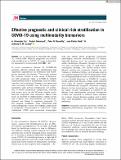Files in this item
Effective prognostic and clinical risk stratification in COVID-19 using multimodality biomarkers
Item metadata
| dc.contributor.author | Liu, Alexander | |
| dc.contributor.author | Hammond, Robert | |
| dc.contributor.author | Donnelly, Peter D | |
| dc.contributor.author | Kaski, Juan Carlos | |
| dc.contributor.author | Coates, Anthony RM | |
| dc.date.accessioned | 2023-05-12T15:30:08Z | |
| dc.date.available | 2023-05-12T15:30:08Z | |
| dc.date.issued | 2023-07-01 | |
| dc.identifier | 285387317 | |
| dc.identifier | c3bc569a-5f51-4aa3-b267-2edec9f428e2 | |
| dc.identifier | 37106509 | |
| dc.identifier | 85158146203 | |
| dc.identifier.citation | Liu , A , Hammond , R , Donnelly , P D , Kaski , J C & Coates , A RM 2023 , ' Effective prognostic and clinical risk stratification in COVID-19 using multimodality biomarkers ' , Journal of Internal Medicine , vol. 294 , no. 1 , pp. 21-46 . https://doi.org/10.1111/joim.13646 | en |
| dc.identifier.issn | 0954-6820 | |
| dc.identifier.uri | https://hdl.handle.net/10023/27606 | |
| dc.description.abstract | In acute coronavirus disease 19 (COVID-19) patients, effective clinical risk stratification has important implications on treatment and therapeutic resource distribution. This article reviews the evidence behind a wide range of biomarkers with prognostic value in COVID-19. Patient characteristics and co-morbidities, such as cardiovascular and respiratory diseases, are associated with increased mortality risk. Peripheral oxygen saturation and arterial oxygenation are predictive of severe respiratory compromise, whereas risk scores such as the 4C-score enable multi-factorial prognostic risk estimation. Blood tests such as markers of inflammation, cardiac injury and d-dimer and abnormalities on electrocardiogram are linked to inpatient prognosis. Of the imaging modalities, lung ultrasound and echocardiography enable the bedside assessment of prognostic abnormalities in COVID-19. Chest radiograph (CXR) and computed tomography (CT) can inform about prognostic pulmonary pathologies, whereas cardiovascular CT detects high-risk features such as coronary artery and aortic calcification. Dynamic changes in biomarkers, such as blood tests, CXR, CT and electrocardiogram findings, can further inform about disease severity and prognosis. Despite the vast volumes of existing evidence, several gaps exist in our understanding of COVID-19 biomarkers. First, the pathophysiological basis on which these markers can foretell prognosis in COVID-19 remains poorly understood. Second, certain under-explored tests such as thoracic impedance assessment and cardiovascular magnetic resonance imaging deserve further investigation. Lastly, the prognostic values of most biomarkers in COVID-19 are derived from retrospective analyses. Prospective studies are required to validate these markers for guiding clinical decision-making and to facilitate their translation into clinical management pathways. | |
| dc.format.extent | 26 | |
| dc.format.extent | 1158433 | |
| dc.language.iso | eng | |
| dc.relation.ispartof | Journal of Internal Medicine | en |
| dc.subject | Biomarker | en |
| dc.subject | Clinical outcomes | en |
| dc.subject | COVID-19 | en |
| dc.subject | Diagnostic performance | en |
| dc.subject | Prognosis | en |
| dc.subject | Risk stratification | en |
| dc.subject | QR355 Virology | en |
| dc.subject | RA0421 Public health. Hygiene. Preventive Medicine | en |
| dc.subject | SDG 3 - Good Health and Well-being | en |
| dc.subject | MCC | en |
| dc.subject.lcc | QR355 | en |
| dc.subject.lcc | RA0421 | en |
| dc.title | Effective prognostic and clinical risk stratification in COVID-19 using multimodality biomarkers | en |
| dc.type | Journal item | en |
| dc.contributor.institution | University of St Andrews. School of Medicine | en |
| dc.contributor.institution | University of St Andrews. Infection and Global Health Division | en |
| dc.identifier.doi | 10.1111/joim.13646 | |
| dc.description.status | Peer reviewed | en |
This item appears in the following Collection(s)
Items in the St Andrews Research Repository are protected by copyright, with all rights reserved, unless otherwise indicated.

